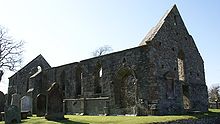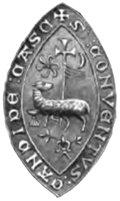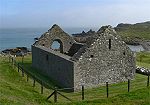
Whithorn Priory
Encyclopedia



Wigtownshire
Wigtownshire or the County of Wigtown is a registration county in the Southern Uplands of south west Scotland. Until 1975, the county was one of the administrative counties used for local government purposes, and is now administered as part of the council area of Dumfries and Galloway...
, Galloway
Galloway
Galloway is an area in southwestern Scotland. It usually refers to the former counties of Wigtownshire and Kirkcudbrightshire...
. It was founded about the middle of the twelfth century, in the reign of David I
David I of Scotland
David I or Dabíd mac Maíl Choluim was a 12th-century ruler who was Prince of the Cumbrians and later King of the Scots...
, by Fergus
Fergus of Galloway
Fergus of Galloway was King, or Lord, of Galloway from an unknown date , until his death in 1161. He was the founder of that "sub-kingdom," the resurrector of the Bishopric of Whithorn, the patron of new abbeys , and much else besides...
, Lord of Galloway
Lords of Galloway
The Lords, or Kings of Galloway ruled over Galloway, in south west Scotland, for a large part of the High Middle Ages.Many regions of Scotland, including Galloway and Moray, periodically had kings or subkings, similar to those in Ireland during the Middle Ages. The Scottish monarch was seen as...
, with Gille Aldan
Gille Aldan
Gille Aldan , of Whithorn, was a native Galwegian who was the first Bishop of the resurrected Bishopric of Whithorn or Galloway. He was the first to be consecrated by the Archbishop of York, who at that time was Thurstan...
, Bishop of Galloway
Bishop of Galloway
The Bishop of Galloway, also called the Bishop of Whithorn, was the eccesiastical head of the Diocese of Galloway, said to have been founded by Saint Ninian in the mid-5th century. The subsequent Anglo-Saxon bishopric was founded in the late 7th century or early 8th century, and the first known...
, for Premonstratensian
Premonstratensian
The Order of Canons Regular of Prémontré, also known as the Premonstratensians, the Norbertines, or in Britain and Ireland as the White Canons , are a Catholic religious order of canons regular founded at Prémontré near Laon in 1120 by Saint Norbert, who later became Archbishop of Magdeburg...
Canons, referred colloquially in Britain as the White Canons.
The canons of Whithorn
Whithorn
Whithorn is a former royal burgh in Dumfries and Galloway, Scotland, about ten miles south of Wigtown. The town was the location of the first recorded Christian church in Scotland, Candida Casa : the 'White [or 'Shining'] House', built by Saint Ninian about 397.-Eighth and twelfth centuries:A...
formed the chapter of the Diocese of Galloway
Diocese of Galloway
The Diocese of Galloway was one of the thirteen dioceses of the pre-1689 Scottish Church. The Diocese was led by the Bishop of Galloway and was centred on Whithorn Cathedral....
, which was re-established about the same time, also by Fergus, the old succession of bishops having died out in the 8th or 9th centuries. The prior
Prior
Prior is an ecclesiastical title, derived from the Latin adjective for 'earlier, first', with several notable uses.-Monastic superiors:A Prior is a monastic superior, usually lower in rank than an Abbot. In the Rule of St...
stood next in rank to the bishop
Bishop
A bishop is an ordained or consecrated member of the Christian clergy who is generally entrusted with a position of authority and oversight. Within the Catholic Church, Eastern Orthodox, Oriental Orthodox Churches, in the Assyrian Church of the East, in the Independent Catholic Churches, and in the...
, as we see from the order of signatories to an espiscopal charter early in the thirteenth century; and he and his community enjoyed the right of electing the bishop, although this right was occasionally overruled in favour of the secular clergy by the Archbishop of York
Archbishop of York
The Archbishop of York is a high-ranking cleric in the Church of England, second only to the Archbishop of Canterbury. He is the diocesan bishop of the Diocese of York and metropolitan of the Province of York, which covers the northern portion of England as well as the Isle of Man...
, of which see Galloway was a suffragan for several centuries.
The full list of priors has not been preserved; among them were: Maurice, who swore fealty to King Edward I of England
Edward I of England
Edward I , also known as Edward Longshanks and the Hammer of the Scots, was King of England from 1272 to 1307. The first son of Henry III, Edward was involved early in the political intrigues of his father's reign, which included an outright rebellion by the English barons...
in 1296; Gavin Dunbar
Gavin Dunbar (archbishop)
Gavin Dunbar was a 16th century archbishop of Glasgow. He was the third son of John Dunbar of Mochrum and Janet Stewart.Gavin Dunbar, his uncle, resigned as Dean of Moray on 5 November 1518 to take up the post of bishop of Aberdeen but managed to secure his former position for his nephew...
(1514), who rose to be Archbishop of Glasgow
Archbishop of Glasgow
The Bishop of Glasgow, from 1492 Archbishop of Glasgow, was the ecclesiastical head of the Diocese of Glasgow and then, as Archbishop of Glasgow, the Archdiocese of Glasgow...
; and James Beaton
James Beaton
Dr. James Beaton was a Scottish church leader, the uncle of Dr. David Cardinal Beaton and the Keeper of the Great Seal of Scotland....
, successively Archbishop of Glasgow and of St. Andrews, and chancellor of the kingdom. Whithorn was long a noted place of pilgrimage, owing to its connection with the venerated memory of Saint Ninian
Saint Ninian
Saint Ninian is a Christian saint first mentioned in the 8th century as being an early missionary among the Pictish peoples of what is now Scotland...
. Many Scottish sovereigns, among them Margaret (queen of James III
James III of Scotland
James III was King of Scots from 1460 to 1488. James was an unpopular and ineffective monarch owing to an unwillingness to administer justice fairly, a policy of pursuing alliance with the Kingdom of England, and a disastrous relationship with nearly all his extended family.His reputation as the...
), James IV
James IV of Scotland
James IV was King of Scots from 11 June 1488 to his death. He is generally regarded as the most successful of the Stewart monarchs of Scotland, but his reign ended with the disastrous defeat at the Battle of Flodden Field, where he became the last monarch from not only Scotland, but also from all...
, and James V
James V of Scotland
James V was King of Scots from 9 September 1513 until his death, which followed the Scottish defeat at the Battle of Solway Moss...
, made repeated pilgrimages to the saint
Saint
A saint is a holy person. In various religions, saints are people who are believed to have exceptional holiness.In Christian usage, "saint" refers to any believer who is "in Christ", and in whom Christ dwells, whether in heaven or in earth...
's shrine
Shrine
A shrine is a holy or sacred place, which is dedicated to a specific deity, ancestor, hero, martyr, saint, daemon or similar figure of awe and respect, at which they are venerated or worshipped. Shrines often contain idols, relics, or other such objects associated with the figure being venerated....
, and left rich offerings behind them. The monastery
Monastery
Monastery denotes the building, or complex of buildings, that houses a room reserved for prayer as well as the domestic quarters and workplace of monastics, whether monks or nuns, and whether living in community or alone .Monasteries may vary greatly in size – a small dwelling accommodating only...
, thus endowed, became opulent, and its income at the dissolution was estimated at over £1000. The last prior (Fleming) was committed to prison in 1563 for the crime of saying Mass. The whole property of the priory was vested in the Crown by the annexation act of 1587, and was granted in 1606 by James VI to the occupant of the See of Galloway when he established Episcopalianism
Scottish Episcopal Church
The Scottish Episcopal Church is a Christian church in Scotland, consisting of seven dioceses. Since the 17th century, it has had an identity distinct from the presbyterian Church of Scotland....
in Scotland in 1606.
It continued to belong to the bishopric until the revolution of 1688, at which date that see was the richest in the kingdom next to St. Andrews and Glasgow. The priory church, which served also as the cathedral
Cathedral
A cathedral is a Christian church that contains the seat of a bishop...
of the diocese, had a long nave
Nave
In Romanesque and Gothic Christian abbey, cathedral basilica and church architecture, the nave is the central approach to the high altar, the main body of the church. "Nave" was probably suggested by the keel shape of its vaulting...
without aisle
Aisle
An aisle is, in general, a space for walking with rows of seats on both sides or with rows of seats on one side and a wall on the other...
s, a choir
Choir
A choir, chorale or chorus is a musical ensemble of singers. Choral music, in turn, is the music written specifically for such an ensemble to perform.A body of singers who perform together as a group is called a choir or chorus...
of about the same length, and a lady chapel
Chapel
A chapel is a building used by Christians as a place of fellowship and worship. It may be part of a larger structure or complex, such as a church, college, hospital, palace, prison or funeral home, located on board a military or commercial ship, or it may be an entirely free-standing building,...
beyond. In 1684 the nave and western tower
Tower
A tower is a tall structure, usually taller than it is wide, often by a significant margin. Towers are distinguished from masts by their lack of guy-wires....
were still intact; but the existing remains consist only of the roofless nave and the extensive vaulted crypts constructed under the eastern end of the church. Such restoration as was possible has been carefully carried out by the third Marquis of Bute.
Burials
- Walter of WhithornWalter of WhithornWalter was Chamberlain of Alan, Lord of Galloway and later Bishop of Galloway. As Alan's chamberlain, he succeeded Bishop John after the latter's death, in 1209...
- Henry of HolyroodHenry of HolyroodHenry was a 13th century Augustinian abbot and bishop, most notable for holding the positions of Abbot of Holyrood and Bishop of Galloway.It is not known when Henry became an Augustinian nor when he became Abbot of Holyrood Abbey...
- Simon de WedaleSimon de WedaleSimon de Wedale O. S. A., was a 14th century Augustinian canon who rose to become Abbot of Holyrood and then Bishop of Galloway. Little is known of Simon until he appears on 27 February 1321 as Abbot of Holyrood Abbey near Edinburgh...
- Archibald Douglas, 5th Earl of AngusArchibald Douglas, 5th Earl of AngusArchibald Douglas, 5th Earl of Angus , was a late medieval Scottish magnate. He became known as "Bell the Cat"...
(heart buried at Douglas, South LanarkshireDouglas, South LanarkshireDouglas is a village in South Lanarkshire, Scotland. It is located on the south bank of the Douglas Water and on the A70 road that links Ayr, on the West coast of Scotland, to Edinburgh on the East, around 12 miles south west of Lanark. The placename is of Gaelic origin, derived from the Old Gaelic...
)
See also
- Prior of WhithornPrior of WhithornThe Prior of Whithorn was the head of the monastic community at Whithorn Priory, attached to the bishopric of Galloway at Whithorn. It was originally an Augustinian establishment, but became Premonstratensian by the time of the second or third known prior...
, for a list of priors and commendators - Isle of WhithornIsle of WhithornIsle of Whithorn is one of the most southerly villages and seaports in Scotland, lying on the coast, north east of Burrow Head, about three miles from Whithorn. Whithorn, , is a former royal burgh in Dumfries and Galloway, with which the Isle of Whithorn is frequently incorrectly amalgamated or...

